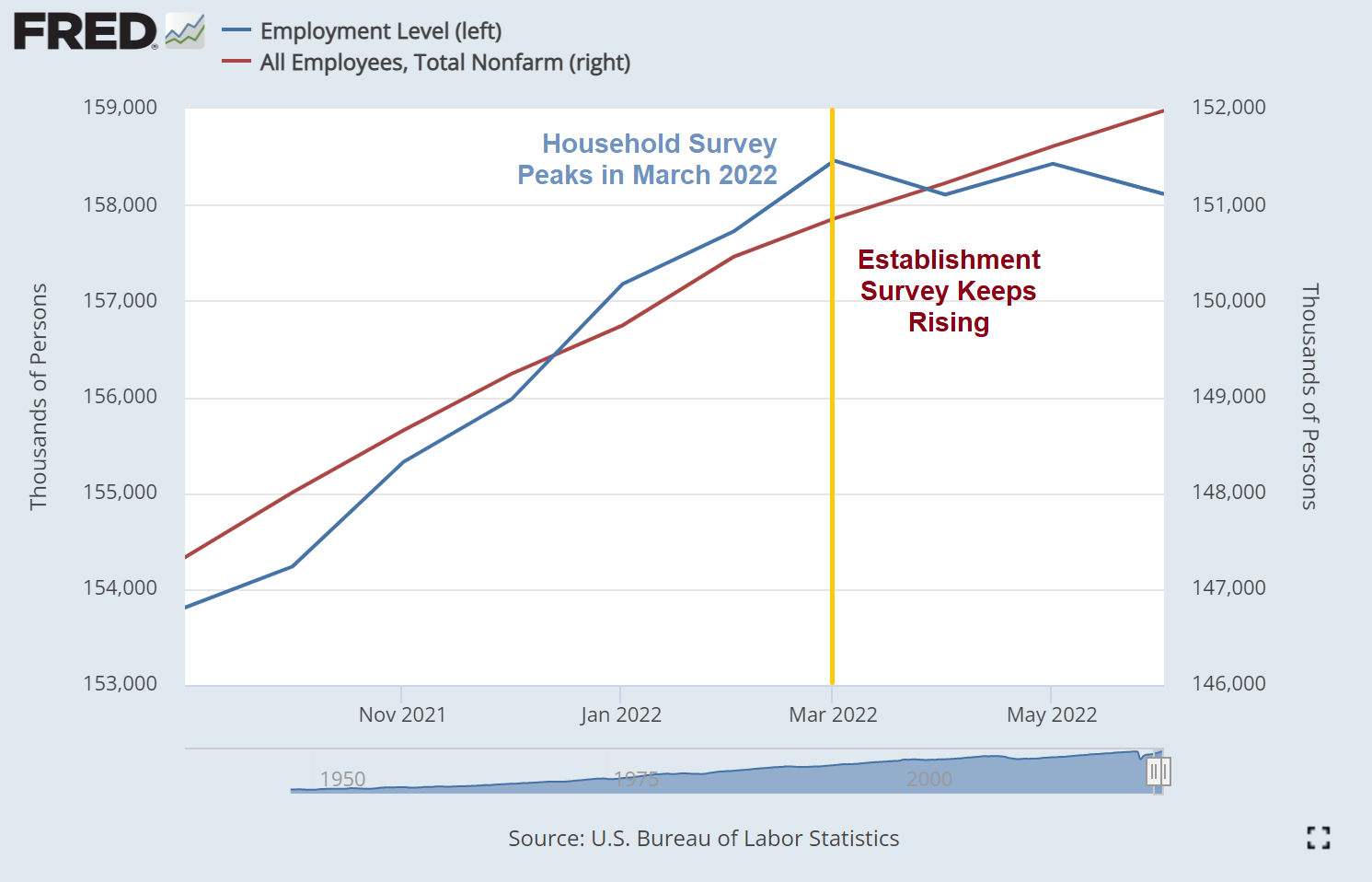Stocks fell this morning on a very strong June jobs report before trading flat through noon. The latest batch of jobs data, released before the market opened, showed a huge payrolls beat (+372k jobs reported vs. +268k expected) alongside climbing hourly wages, which jumped 0.3% month-over-month (MoM), matching expectations. Unemployment remained unchanged at 3.6%.
The surprisingly large beat flew in the face of recent economic data that suggested the US has already entered a recession. But perhaps the most stunning disconnect was found in the Bureau of Labor Statistics’ (BLS) very own June household survey. The household survey is designed to measure the size of the labor force in the US with demographic detail. This survey is where the BLS derives the unemployment rate from.
And over the last three months, the household survey’s findings have not aligned with the headline jobs numbers (aka the establishment survey). June’s household survey actually reported a 315,000 decline in jobs. April’s household survey showed a similarly striking drop of 353,000 jobs opposite a headline April jobs report gain of 428,000 payrolls.
May’s household survey matched the establishment survey, but April and June did not in the slightest.
That’s probably what caused the recent dip in the labor force participation rate, which now sits flat since the start of the year after rising in Q1.
Cumulative discrepancies between the household and establishment surveys have created a major gap that began forming in March, too.

That’s abundantly clear when you plot both surveys on a chart. The household survey peaked back in March while the establishment survey just kept on rising. Over the last three months, the establishment survey shows a gain of 1.124 million jobs vs. the household, which shows a net employment loss of 347,000. That’s a total difference of about 1.5 million jobs.
How is this possible, you may ask? It all has to do with the demographics of the household survey, which divides workers into three categories:
Full-time, part-time, and multiple jobholders.
Full-time employees declined by 70,000 since March while part-time workers fell by 326,000. Multiple jobholders, on the other hand, have surged to a post-Covid high of 7.541 million. Multiple jobholders swelled by 239,000 in June alone opposite full-time and part-time workers, who fell by 152,000 and 326,000 last month, respectively.
But it gets even worse.
Multiple jobholders whose primary and secondary jobs are both full-time just hit a record high as well.
In short, there are far fewer people working than the last handful of jobs reports would suggest. There has, however, been a sharp increase in the number of people working multiple jobs. This is reflected in the recent jobs beats, which count the number of total payrolls, not workers.
Does that sound like the kind of thing that happens when the economy is strong? Not at all. Usually, folks are happy to have only one employer during times of economic prosperity.
The reality here is that US labor is not in a healthy place. What’s more, the US is experiencing a labor shortage during what seems to be the early stages of a recession.
And it should only get worse as high-quality jobs fall opposite ones that are taken by workers already employed elsewhere. Investors saw this morning’s jobs beat as a potentially bearish impulse, as it suggested that the economy was strong enough to handle an aggressive rate hike schedule from the Fed.
The truth is that it’s a bearish impulse for an entirely different reason. US labor is in shambles, hidden by headline jobs gains that the BLS uses as a smokescreen. It’s another sign that this recession is going to be far more intense than most expect, and when the market realizes that, share prices should react very negatively in turn.








